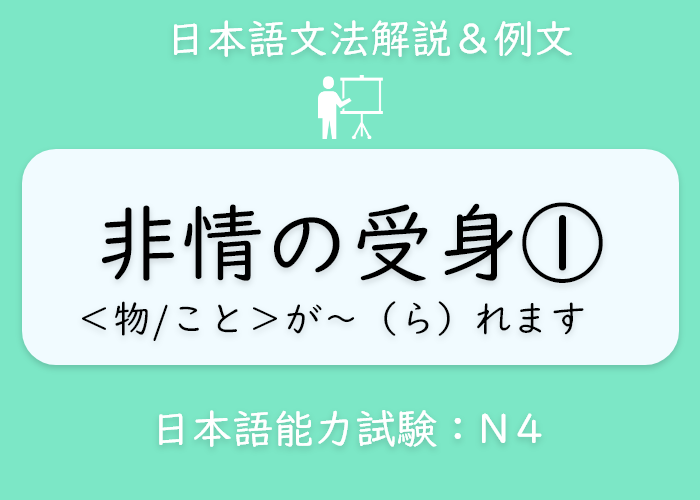
「非情の受身」(「物/こと」が主語の受身)の説明を英語・イラスト付きで説明します。
●意味:
<物/こと>を主語にして、社会的な事実や事柄を言うときに使う。
Use <thing/matter> as the subject when referring to social facts or matters.
●接続:
Ⅰグループ(ない形)+れる
Ⅱグループ(ない形)+られる
Ⅲグループ する→される くる→こられる
●日本語能力試験:
N4
●備考:
〇<物/こと>が主語である「非情の受身」では、客観的な意味を表すため、新聞やニュース、本などでよく使われる。
It is often used in newspapers, news, books, etc.
〇この受身は、最も話したい<物/こと>が主語になることで受身文となる。
In this passive sentence, the subject is the <thing/matter> that you want to talk about the most.
〇人を主語にした「持ち主の受身」では「迷惑だ」という感情があったが、物/ことを主語にした「非情の受身」では感情はなく、事実を客観的に述べる。
In the "owner's passive" with the person as the subject, there was an emotion of "it's annoying", but in the "unsympathetic passive" with the thing/matter as the subject, there is no emotion, and the facts are stated objectively.
〇この受身は、誰がその行為をしたかは重要ではないので、文の中には明記しない。
In this passive, it is not indicate who performed the action in the sentence.
〇行為者が有名な人や特定の人である場合は、「~によって」を使って表す。
If a famous person or a specific person did the action, use "niyotte".
●1958年に東京タワーが建てられました。
Tokyo Tower was built in 1958.
●1983年に東京ディズニーランドが作られました。
Tokyo Disneyland was built in 1983.
●1998年に長野オリンピックが行われました。
The Nagano Olympics were held in 1998.
●752年に奈良の大仏が作られました。
The Great Buddha of Nara was created in 752.
●1397年に金閣寺が建てられました。
The Kinkakuji Temple was built in 1397.
●2012年にスカイツリーが建てられました。
The Sky Tree was built in 2012.
●1971年にカラオケが発明されました。
Karaoke was invented in 1971.
●浅草寺はいつ建てられましたか?
When was Senso-ji built?
→(浅草寺は)628年に建てられました。
Senso-ji Temple was built in 628.
●インスタントラーメンはいつ発明されましたか?
When was instant ramen invented?
→(インスタントラーメンは)1958年に発明されました。
Instant noodles were invented in 1958.
©copy right Langoal. All Rights Reserved.